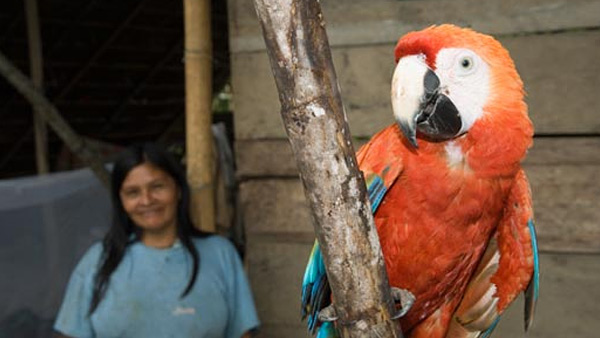
|  |  |  Editorials | Environmental Editorials | Environmental  
Wildlife Trafficking - Part 4
 Charles Bergman - Smithsonian.com Charles Bergman - Smithsonian.com
go to original
January 10, 2010

Smithsonian magazine, December 2009


| | A Huaoroni woman stands in the background as her pet scarlet macaw takes center stage. “Scarlet macaws are a study in primary colors-fiery red, cadmium yellow and dark blue,” says Bergman. (Charles Bergman) |  |
Many experts say wild parrots can no longer sustain such losses. Of the 145 parrot species in the Americas, 46 are at risk of extinction. And the rarer the species, the more valuable it is to poachers—which only puts more pressure on the few remaining specimens. A single Lear's macaw, one of the coveted "blue macaws" from Brazil, can ultimately sell for $10,000 or more. The trade can send even apparently healthy species over the edge. Charles Munn, a parrot researcher at Tropical Nature, a Philadelphia-based conservation group that advocates ecotourism, told me, "If you shoot macaws for meat or feathers, or if you take the babies from the nest, you can wipe them out quickly. Poaching can get out of control quickly."

Several weeks after our first visit, we headed back to the scarlet macaw nest in a large canoe powered by a 25-horse-power motor. I had been thinking a lot about the macaws, wondering if I could persuade Paa not to cut down the tree.

It was just a couple of days before a feria, or market day, at a small town upstream from the nest. Canoes loaded with people and merchandise passed us; the passengers had been traveling for days, camping on sandbars. After reaching a dirt road built by the oil companies, they would hitchhike or walk another 15 miles to the village. Many canoes held animals. We stopped to visit with one boatload of 14 people, from elders to small babies. The driver offered to sell me an armadillo. It could be a pet or a meal, he said. He pulled a struggling baby armadillo, still pink, from a bag. He would let me have it for $20.

In the middle of the canoe were boxes of smoked meat. The charred hand of a monkey stuck out of one, fingers clenched. Indigenous people may legally hunt for subsistence purposes, but carne del monte, or wild meat, is illegal to sell without approval from the Ministry of Environment. Still, the meat is popular. At a market in the Ecuadoran Amazon Basin I saw for sale the meat of turtles, agoutis (a large rodent), armadillos and monkeys—all illegal. Other people on their way upriver to the feria carried peccaries (related to pigs), blue-headed parrots and parakeets. Selling them is just about the only way they had of making a few dollars.

The canoes carrying meat and animals for sale increased my worries about the scarlet macaws. Still, I had reason to hope the nest was intact. Paa said he had not heard anything about them. And two weeks earlier, I had heard through friends that Fausto had seen the birds at the nest on one of his trips downriver. Fausto was not with us this time. This canoe belonged to two young Huaorani brothers with English names, Nelson and Joel.

When we rounded the bend near the nest, the two macaws were sitting together on a branch. Their backs to us, they gleamed red in the morning sun. Their long tails waved and shimmered in the soft breeze. When they saw us, the birds screamed, lifted from their branch and disappeared into the dark forest. I was relieved to see them.

Then we saw the fresh footprints on the shore. We raced to the nest. The tree lay on the ground, smashed and wet. There were no chicks. All that remained were a few wet and mangled feathers near the nest hole.

We stood around the tree, speechless, as if by a coffin. Paa said he had not taken the chicks—someone else had. He shrugged. I was coming to realize, regardless of the laws in big cities, that capturing animals in the jungle is common. It's not the shadowy activity people might think; it's more like an open secret. The downed tree, to me, represented all the waste and destruction of this illicit trade, which destroys not only wild parrots but also the trees that serve as nest sites year after year. Thus trafficking harms future generations, too.

We did not know whether the babies survived the crash of the tree onto the ground. (A recent study in Peru found that 48 percent of all blue-and-yellow macaws die when their trees are felled.) Even after the nest had been robbed, the parent macaws had stayed by the downed tree, the image of fidelity and loss.


|

 |
|  |



